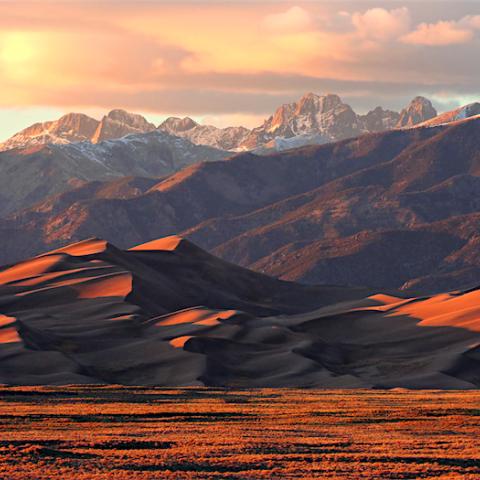
The author invites you to explore Great Sand Dunes National Park and Preserve/Courtesy
Great Sand Dunes National Park and Preserve in Colorado offers a much bigger and more accessible dune field than any other unit of the National Park System. These are, in fact, the highest dunes in North America and have been protected since local residents successfully lobbied for a 1932 national monument proclamation.
The area was expanded to its current boundaries and renamed a park and preserve in 2000. The sand captured in these dunes originated about 65 miles west in the San Juan Mountains. As the sand blew east it mixed with sand and pebbles washed down from the Sangre de Cristo Mountains and it was all stirred together in an ancient lake. As that lake receded, the prevailing winds from the west pushed the sand up against the Sangre de Cristo Mountains and created dunes that today are over 750 feet high.
My girlfriend Craig and I rolled into the Pinon Flats campground mid-afternoon one day last fall and easily found a place to park our little Alto trailer for a three-day stay. The campground is open April through October and reservations are accepted from May to September. In addition to information on how to safely explore the dunes, the visitor center oriented us to hiking options in the juniper-pinon woodlands at the dunes' edge, as well as trails to higher elevations into a subalpine and alpine tundra environment in the Sangre de Cristo Mountains. We didn’t get into the high country, preferring to explore the sand.
The campground is a stone’s throw to the dune field, so we hiked from our campsite. Medano Creek is your first obstacle. We were there in October, so it was very shallow and easily crossed without getting our boots wet. A unique feature of this creek are these mesmerizing wave-like pulses of water caused by water building behind small ridges of sand in the creek bed and as these ridges give way, a small surge of water flows downstream. We timed our crossing to avoid these pulses, dancing across the stream and on to the dunes.

Medano Creek and mountains, Great Sand Dunes National Park and Preserve/Jim Stratton
The dunes are a series of windblown ridges and we set our sights on a mid-dune ridge about halfway up. The thought of climbing up 750 feet in shifting sands to the top of Star Dune (one of the park’s highest) made my calves spasm in anticipation. But once we started out, the sand was firmer than we expected.
We were not climbing where many others had gone and later we found that once the sand was loosened by lots of hikers on the more popular routes, it was a bit of a grind. But on this less-traveled sand we easily walked up ridges that beckoned us to see what was beyond the next highest one. Soon we were on top, standing on Star Dune and gazing across thousands of acres of shifting sands. And, as in Kobuk Valley National Park in Alaska, we discovered life on the dunes. We followed tracks of beetles, had ladybugs land on our hats, watched ravens surf the wind, and wondered where butterflies thought they would score some nectar high in the sand. And coming down was way easier and a lot faster than climbing up!
The next day the wind was really blowing and hiking on the sand was a non-starter. Good thing we did our dune walk when the wind was but a mere whisper. So we explored the juniper-pinon forest on the Wellington Ditch Trail, just above the sand edge – a very reasonable one-mile trail from the campground to the visitor center. As an added bonus, after years of looking, I saw my first pinon jays!! A whole flock went squawking by, and I imagine my “I-just-saw-the-bird” dance was a little amusing for those on the visitor center deck. Glad I was able to entertain them!
This is very much a "local" campground with lots of campers from Pueblo and Colorado Springs. On one of our campground walks, we ran into a group of Boy Scouts and their leader told us about a nearby hot springs. Our aching muscles rejoiced! Don’t let the name get in the way – Sand Dunes Swimming Pool and RV Park. It is about an hour away in Hooper, Colorado, and, in addition to the swimming pool that was full of kids, there is the Greenhouse, an adults-only section with four different soaking pools of varying temperatures and a bar!! We took advantage of a nice hot soak to ease the muscles that were talking to us after our day of hiking in sand. And on the way over, we stopped off at San Luis State Wildlife Area to watch the Sandhill cranes come in for the evening. A fine way to end the day.

The winds will erase the tracks of those that came to the dunes/Jim Stratton
Editor's note: Jim Stratton long served as the Alaska regional director for the National Parks Conservation Association. For more of his stories, check out his blog.


 Support Essential Coverage of Essential Places
Support Essential Coverage of Essential Places







Comments
we got to go there about 6 years ago and loved it my dogs uncovered snow from the sand dunes and ran and played in the sand we had a great day there
I love this place. Rubbed our hands on the sand and got to hear it sing?